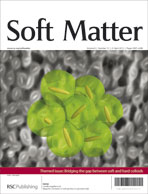Yielding dynamics of a Herschel–Bulkley fluid: a critical-like fluidization behaviour†
Abstract
The shear-induced fluidization of a carbopol microgel is investigated during long start-up experiments using combined ![[small gamma, Greek, dot above]](https://www.rsc.org/images/entities/i_char_e0a2.gif) . Here we go one step further by an exhaustive investigation of the influence of the shearing geometry through the gap width e and the boundary conditions. While slip conditions at the walls seem to have a negligible influence on the fluidization time τf, different fluidization processes are observed depending on
. Here we go one step further by an exhaustive investigation of the influence of the shearing geometry through the gap width e and the boundary conditions. While slip conditions at the walls seem to have a negligible influence on the fluidization time τf, different fluidization processes are observed depending on ![[small gamma, Greek, dot above]](https://www.rsc.org/images/entities/i_char_e0a2.gif) and e: the shear band remains almost stationary for several hours at low shear rates or small gap widths before strong fluctuations lead to a homogeneous flow, whereas at larger values of
and e: the shear band remains almost stationary for several hours at low shear rates or small gap widths before strong fluctuations lead to a homogeneous flow, whereas at larger values of ![[small gamma, Greek, dot above]](https://www.rsc.org/images/entities/i_char_e0a2.gif) or e, the transient shear band is seen to invade the whole gap in a much smoother way. Still, the power-law behaviour appears to be very robust and hints to critical-like dynamics. To further discuss these results, we propose (i) a qualitative scenario to explain the induction-like period that precedes full fluidization and (ii) an analogy with critical phenomena that naturally leads to the observed power laws if one assumes that the yield point is the critical point of an underlying out-of-equilibrium phase transition.
or e, the transient shear band is seen to invade the whole gap in a much smoother way. Still, the power-law behaviour appears to be very robust and hints to critical-like dynamics. To further discuss these results, we propose (i) a qualitative scenario to explain the induction-like period that precedes full fluidization and (ii) an analogy with critical phenomena that naturally leads to the observed power laws if one assumes that the yield point is the critical point of an underlying out-of-equilibrium phase transition.

- This article is part of the themed collection: Bridging the gap between soft and hard colloids

 Please wait while we load your content...
Please wait while we load your content...